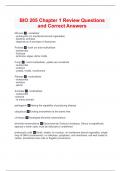Exam (elaborations)
BIO 205 Chapter 1 Review Questions and Correct Answers
- Course
- Institution
Monera - unicellular - prokaryotic (no membrane bound organelles) - bacteria, archaea - depends on # and type of ribosomes Protista - both uni and multicellular - eukaryotes - Eukarya - protozoa, algae, slime molds Fungi - most multicellular, yeasts are unicellular - eukaryotes - eukarya - yeasts...
[Show more]




